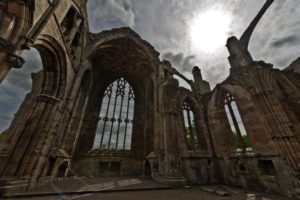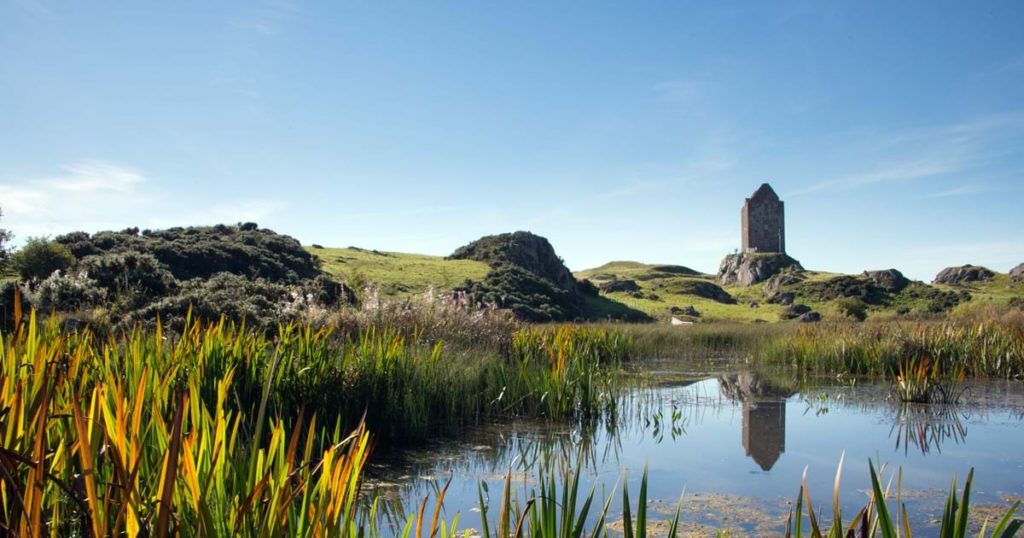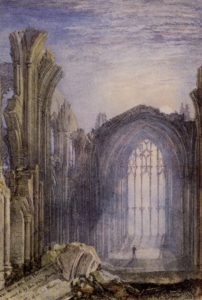
Sir Walter Scott’s famous poem The Lay of the Last Minstrel was an instant success when it was published in 1805, winning Scott international fame and putting Scotland on the map as a tourist destination for the first time. The poem could be viewed as a kind of guidebook for our tour of Scotland (click here to read The Lay of the Last Minstrel Overview). And it all happened because of the way the moonlight fell on Melrose Abbey.
Scott set the poem in the landscape and among the monuments he knew from spending much of his youth in the Border counties. In the poem, the eponymous “Last Minstrel” tells his story of a sixteenth century Border feud to Ann, Duchess of Buccleuch [buck-LOO], some hundred and fifty years after the event. (Remember Diana Rigg as the Duchess of Buccleuch–a descendant of Ann–in Season 2 of Victoria?) Creating a narrative within a narrative was a common approach in the novels of the eighteenth and nineteenth centuries; it was a way of blurring the boundaries between fiction and nonfiction to lend an air of verisimilitude to the story. The tale is told at Newark Castle, a ruined edifice on the Bowhill estate, a most romantic location, which we will visit during our stay in Melrose.

Newark Castle has another claim to our notice related to the poem. Scott and William Wordsworth had been friends since the publication of The Lay in 1805. They visited each other in the landscapes each had made famous in poetry: Scott showed Wordsworth around Melrose Abbey on that first visit, and Wordsworth hosted Scott in Grasmere later on. Both writers play important roles in the birth of literary tourism, and they themselves were among the first literary tourists. Wordsworth came to see Scott for the last time in 1831, and together they visited Newark Castle, the two most famed poets of the English language in their day musing on Scott’s poem and the castle’s romantic past, no doubt. Both were ill, but though Wordsworth would have many more years to live (he died in 1850), Scott would die the next year.

Scott’s poetry and novels grew out of a love for local history and legends he developed as a child visiting his grandparents at their farm near Smailholm Tower between Melrose and Kelso. We’ll pay a visit to this place on the day we also see Abbotsford, Scott’s Gothic revival estate. Smailholm is a “peel” tower, one of many built to help in defending Scotland from English invasions all across the Border counties. Perched on a knoll, this sturdy tower still affords dramatic views on all sides of a landscape one can easily fill with imagined soldiers on horseback, minstrels roving the countryside looking for an audience, lords and ladies, workers toiling in the vast fields around the tower, and other characters from the sixteenth century.
Later in the course of the Border feud story, a key scene takes place at Melrose Abbey. In Canto II of his long poem, Scott describes the abbey “lit by the pale moonlight.” Melrose would never be the same. The popularity of the poem and that passage immediately drew hundreds of visitors to the village, hoping for a chance to see this phenomenon. Until this time, people from south of the border had not really considered traveling to Scotland, which had the reputation of being wild and barren. The Lay of the Last Minstrel stirred interest not only in historical poetry but also in the landscapes in which the events had happened. Take a look at the description of the abbey to see why this was so.
If thou wouldst view fair Melrose aright,
Go visit it by the pale moon-light;
For the gay beams of lightsome day
Gild, but to flout, the ruins gray.
When the broken arches are black in night,
And each shafted oriel glimmers white;
When the cold light’s uncertain shower
Streams on the ruined central tower;
When buttress and buttress, alternately,
Seem framed of ebon and ivory;
When silver edges the imagery,
And the scrolls that teach thee to live and die;
When distant Tweed is heard to rave,
And the owlet to hoot o’er the dead man’s grave,
Then go—but go alone the while—
Then view St. David’s ruined pile;
And, home returning, soothly swear,
Was never scene so sad and fair!

These are lovely lines of poetry—and there’s lots more where they came from! The vivid description of the abbey immediately captures the imagination, inviting the reader to imagine being in that landscape. Influenced by ballads and the verse forms of the old Scottish poets, the four beat lines (said to have been inspired by a performance Scott heard of Coleridge’s “Christabel”) and the couplet rhymes create an energetic, galloping rhythm. The mellifluous diction, visual images, and sensory details make the world of the poem come alive. Scott, like the other Romantic poets but especially Wordsworth, put real places into his poems—the abbey, the River Tweed, Melrose itself, and many more—which would have added interest to the lines. This move seems obvious to us today, but before the Romantics, poets and artists were attracted to more idealized landscapes. Scott was interested in past events, in what happened, but he found a way to bring that world home to his readers in terms they could feel and understand. No wonder Scott’s poem gained such popularity, and no wonder people came from all over Europe and North America to relive their favorite moments from the poem.
I regret now that I did not plan our trip to Scotland around the phases of the moon, so that we too, could see “Fair Melrose lit by the pale moonlight.” Of course, there’s no guarantee that the weather would have allowed us to see it.

Canto VI of the poem makes many references to Rosslyn, the castle and the chapel, which we will be visiting on our way north to Loch Lomond. Dan Brown, author of The Da Vinci Code, was not the first writer to see the possibilities of Rosslyn Chapel as a dramatic setting, though I’m afraid more visitors go there today for the sake of his novel and the film with Tom Hanks than for the sake of The Lay of the Last Minstrel. When you see this gorgeous church, think of Scott’s description of it as a fire rages nearby:
Seem’d all on fire that chapel proud
Where Roslin’s chiefs uncoffin’d lie,
Each baron, for a sable shroud.
Sheath’d in his iron panoply.Seem’d all on fire within, around
Deep sacristy and altar’s pale;
Shone every pillar foliage-bound,
And glimmer’d all the dead men’s mail.
There are other mentions of Rosslyn in Canto VI. Scott visited the chapel many times and perhaps saw its potential as a tourist destination that would contribute to the fame of his poem. He was very much an entrepreneur and, of course, an advocate of all things Scottish.
The first lines of Canto VI of The Lay of the Last Minstrel are often excerpted and presented as a stand-alone poem. While they make no reference to places we’ll visit, I think they capture something of what Scott brought to literature and to Scottish national identity—the pride and personal meaning one takes from belonging to a place: “This is my own, my native land!”
Breathes there the man, with soul so dead,
|Who never to himself hath said,
This is my own, my native land!
Whose heart hath ne’er within him burn’d,
As home his footsteps he hath turn’d
From wandering on a foreign strand!
If such there breathe, go, mark him well;
For him no Minstrel raptures swell;
High though his titles, proud his name,
Boundless his wealth as wish can claim;—
Despite those titles, power, and pelf,
The wretch, concentred all in self,
Living, shall forfeit fair renown,
And, doubly dying, shall go down
To the vile dust, from whence he sprung,
Unwept, unhonour’d, and unsung.

Lovely! Do you know in which phase the moon will be?
The third quarter I believe, if that!
Just to walk around Melrose will be a joy. I’m sure Melrose Abbey will be spectacular in any light. Can’t wait to see Rosslyn Chapel; I’ll be peering at every green face and imagining links to Creevykeel (and I’d be bowed over if I learn of any historical ties!)
Is angone watching “Great Estates of Scotland” on PBS Atlanta? It’s about Rosslyn Chapel and will air again on Sunday, May 13 at noon.
Thanks for that tip! I caught the end of it and hoped it would rerun.
I, too, caught the end of it on PBS. Also found a BBC Documentary on YouTube https://www.youtube.com/watch?v=ub_yGhfhsEw